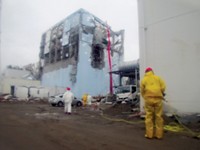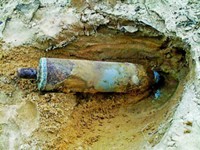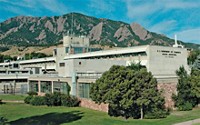Advertisement
Grab your lab coat. Let's get started
Welcome!
Welcome!
Create an account below to get 6 C&EN articles per month, receive newsletters and more - all free.
It seems this is your first time logging in online. Please enter the following information to continue.
As an ACS member you automatically get access to this site. All we need is few more details to create your reading experience.
Not you? Sign in with a different account.
Not you? Sign in with a different account.
ERROR 1
ERROR 1
ERROR 2
ERROR 2
ERROR 2
ERROR 2
ERROR 2
Password and Confirm password must match.
If you have an ACS member number, please enter it here so we can link this account to your membership. (optional)
ERROR 2
ACS values your privacy. By submitting your information, you are gaining access to C&EN and subscribing to our weekly newsletter. We use the information you provide to make your reading experience better, and we will never sell your data to third party members.
Safety
Plutonium plant removal halted after radiation releases
Corrective measures include better control measures, communication with workers
by Jeff Johnson, special to C&EN
April 18, 2018
| A version of this story appeared in
Volume 96, Issue 17

The Department of Energy (DOE) has called for 42 actions to correct safety deficits that led to a series of radioactive releases during demolition of the now-closed plutonium processing facility at the former Hanford nuclear weapons production site in Washington state.
The actions include better application of coatings and use of other technologies to control spread of radioactive contamination, broader radiation boundaries, improve air dispersion measurement and modeling, greater involvement of employees as demolition moves ahead, and better training of and communication with site workers to solicit their input.
Following the releases, site remediation halted last December. Several hundred workers were tested for radiation exposure. Test results showed that several dozen workers had inhaled or ingested detectable radiation but at levels acceptable to the department.
The shutdown only affects demolition of the plutonium facility, but that is a significant part of the $2 billion a year Hanford cleanup. Hanford, in turn, is the largest component in what is the world’s more expensive remediation program. During World War II and the Cold War, the Hanford site was one of more than 100 U.S. plants that made nuclear weapons components. All the plant sites are undergoing some level of remediation.
The radiation exposure incidents at Hanford occurred last year and DOE’s analysis of what happened was released publicly in March. Additionally, DOE recently announced an additional internal but independent review of the plutonium demolition project. That analysis will be “ongoing,” according to DOE’s Office of Enterprise Assessments, which will conduct the review. An official with the office would not predict when oversight will end.
The demolition and remediation will not restart until the Washington State Department of Ecology and the U.S. Environmental Protection Agency, which regulate Hanford cleanup activities, are satisfied the operation is safe, according to DOE and Washington state officials.
The plutonium finishing facility turned plutonium nitrate solutions into solid, hockey-puck-sized plutonium “buttons” that could be shipped to other facilities. It once was a complex of some 90 building and was shut down in the 1980s. Cleanup began in 1989; demolition began in 2016.
Last June and again in December, demolition activities contaminated workers and vehicles at the site. Small levels of radiation were found away from the plutonium facility but still within the Hanford site. No detectable amounts were found in workers’ homes, DOE says.
In the March report, DOE says 281 workers requested bioassays and were tested following the December release. The results found two doses less than 1 millirem, eight doses between 1 to 10 mrem, and one dose between 10 to 20 mrem. DOE sets the acceptable level at 100 mrem/year for nonradiological workers and members of the public and 500 mrem/year for radiological workers.
Following the June release, some 300 workers requested testing and bioassays found elevated radiation exposure for 31 workers, DOE says.





Join the conversation
Contact the reporter
Submit a Letter to the Editor for publication
Engage with us on Twitter